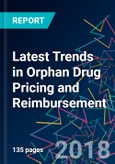It is now some 35 years since the passage of the first law designed specifically to encourage investment in the discovery and development of rare disease treatments. Activity in the sector has been transformed since then. Once a neglected backwater, orphan drug development is now the subject of a research boom that is delivering innovative new treatments for rare diseases to the market in unprecedented numbers. Many carry premium price tags, and while overall pharmaceutical market growth rates have slowed, spending on orphan drugs is rising at double-digit rates.
Recent trends have sparked a debate on the structure of existing orphan drug laws, which critics say have been overtaken by scientific developments and are being exploited by the pharmaceutical industry. Regulators in both the US and Europe have announced plans to review current legislation, but opposition to substantive amendments on both sides of the Atlantic is strong, and major change appears unlikely in the foreseeable future. In the meantime, payers are being asked to fund orphan drug coverage bills that will reach new heights as the first wave of gene therapy products reaches the market. With their budgets under growing pressure, payers in most markets have begun to push back, implementing measures designed to limit their exposure to costs associated with orphan drug reimbursement.
This report provides a detailed analysis of orphan drug coverage, funding, and pricing systems in the US, Japan, and the EU's five biggest pharmaceutical markets (France, Germany, Italy, Spain and the UK). It also tracks recent developments in orphan drug pricing and reimbursement across these seven countries, and describes the impact of those changes on rare disease treatments in general, and on specific products in particular. Finally, it addresses some of the major issues facing payers and orphan drug manufacturers, highlighting the way these have been handled by both parties through individual case studies.
Recent trends have sparked a debate on the structure of existing orphan drug laws, which critics say have been overtaken by scientific developments and are being exploited by the pharmaceutical industry. Regulators in both the US and Europe have announced plans to review current legislation, but opposition to substantive amendments on both sides of the Atlantic is strong, and major change appears unlikely in the foreseeable future. In the meantime, payers are being asked to fund orphan drug coverage bills that will reach new heights as the first wave of gene therapy products reaches the market. With their budgets under growing pressure, payers in most markets have begun to push back, implementing measures designed to limit their exposure to costs associated with orphan drug reimbursement.
This report provides a detailed analysis of orphan drug coverage, funding, and pricing systems in the US, Japan, and the EU's five biggest pharmaceutical markets (France, Germany, Italy, Spain and the UK). It also tracks recent developments in orphan drug pricing and reimbursement across these seven countries, and describes the impact of those changes on rare disease treatments in general, and on specific products in particular. Finally, it addresses some of the major issues facing payers and orphan drug manufacturers, highlighting the way these have been handled by both parties through individual case studies.
Table of Contents
1 EXECUTIVE SUMMARY
2 THE ORPHAN DRUGS EXPLOSION
3 ORPHAN DRUG COVERAGE, FUNDING, AND PRICING
4 US
5 UK
6 FRANCE
7 GERMANY
8 ITALY
9 SPAIN
10 JAPAN
11 ORPHAN DRUG CASE STUDIES
LIST OF TABLES








